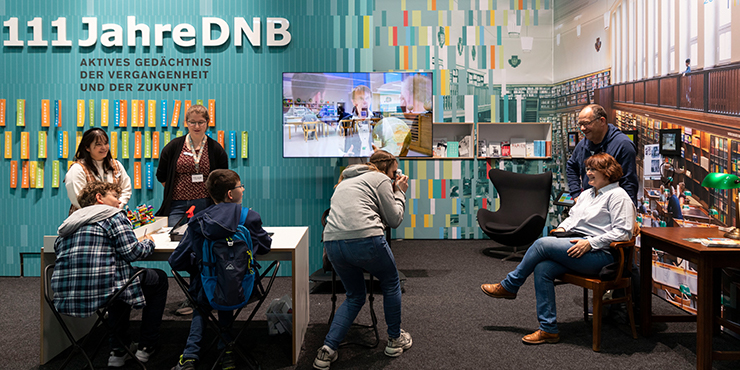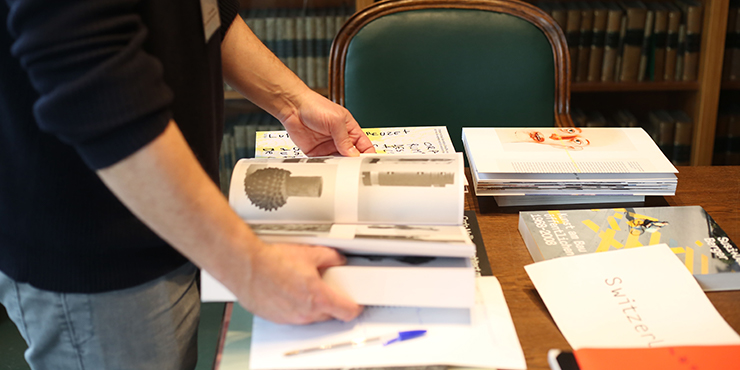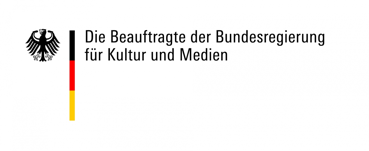More digital indexing
 Photo: Stephan Jockel
Photo: Stephan Jockel
Making media ready for use: cataloguing media works
As the memory of the nation, the German National Library collects all text, image and sound recordings which have been published in Germany, in the German language or on Germany since 1913 – without exception, without bias and in the original. However, collecting alone is not enough. The DNB's statutory tasks also include cataloguing the collected media, since this is the only way in which users can benefit from them.
Cataloguing is the basis for finding and using the holdings in the catalogue. Cataloguing means using metadata to describe a media work – a book, a journal, a website, a map or a sheet music – in such a way that it can be found in an online catalogue or database. The data generated is incorporated into the "Deutsche Nationalbibliografie" (German National Bibliography).
How does the German National Library catalogue its holdings?
The German National Library employs a variety of processes. Its collections are catalogued descriptively and by subject. Descriptive cataloguing facilitates searches for individual media works using information such as persons, titles, publishers, ISBN, ISSN, URN, and DOI. Subject cataloguing is used to structure the collections thematically using subject headings, DDC Subject Categories, DDC numbers and genre terms. In cataloguing work, we use cataloguing standards, authority data and classifications.
This combined approach to subject cataloguing serves a range of customer requirements. Interested users can perform searches using natural language – i.e. subject headings – and benefit from the use of library classification systems to group publications by subject. (Example of number: 610 Medicine).
Human input is indispensable
Physical media are primarily catalogued intellectually, i.e. by DNB staff, mostly without the help of machine-based processes. In 2023, they catalogued more than 153,000 media works ; around 42,000 publications underwent in-depth subject cataloguing using subject headings and/or Dewey Decimal Classification numbers. Data supplied by the depositing publishers and copyright holders were used in the records created for digital objects.
Some parts of the subject cataloguing process are performed automatically – and have been since 2012. This facilitates the systematic subject cataloguing of publications such as individual online articles which could not be considered otherwise. Machine-based cataloguing encompasses the classification of media using Subject Categories such as 610 Medicine and health and DDC Short Numbers such as 612.1 Circulatory system as well as the assignment of subject headings using GND vocabulary. EMa, the cataloguing machine developed at the DNB, is used on a daily basis for the fully automated subject cataloguing of online publications in particular. EMa also uses algorithms from the open-source tool kit Annif, which was developed by the Finnish National Library.
Exponential growth of machine-based cataloguing
The DNB is actively involved in the ever-growing communities that have grown up around the topic of machine-based cataloguing, e.g. the Annif user group. In 2023, approx. 1,328,600 publications were catalogued automatically using Subject Categories, approx. 1,062,700 using DDC Short Numbers, and approx. 167,500 using GND subject headings. In all, these figures are approx. 60% higher than those achieved through machine-based cataloguing in 2022.
Everything under one roof: New platform of the STA
Nothing is possible without joint standards: common standards, reference points and rules of use are necessary to exploit the full potential of the large volumes of data in the humanities and cultural sciences. This is where the Committee for Library Standards creates uniformity. In 2023, the documentation platform of the Committee for Library Standards went online.
The platform's purpose? To provide convenient, machine-readable access to all rules and documents relating to cataloguing and work with the GND authority database – all at one location. The platform currently encompasses the RDA DACH standard and the GND format documentation. The DNB has been using the revised RDA DACH standard in its cataloguing work since the fourth quarter of 2023.
Simplified content searching
The interlinked standards are now being jointly presented in one environment for the first time. The staff responsible for cataloguing benefit from the searchability of the content, the user-friendly navigation and the various types of catalogue access, e.g. through elements, resource types or user profiles. 2024 will see further resource type descriptions added to the platform in the RDA DACH area. The standards for cataloguing GND authority data will also be integrated into the platform. The necessary foundations and concepts are being developed by a project team within the GND cooperative.
Bessere Zusammenarbeit der Fach- und Arbeitsgruppen
Along with the developmental activities, work was also carried out on an editing environment for the STA documentation platform. This will enable STA expert groups and working groups to plan, develop and coordinate changes and additions to cataloguing rules along with definitions. The resulting changes to the standards will be published in releases scheduled to appear on the platform twice a year. The STA documentation platform and the editing environment will in future provide crucial support for the work carried out jointly by the expert groups and working groups on the cooperatively used and maintained standards.
Click here for the STA documentation platform.
Here you can find further information on RDA and the Common Authority File (GND).
News from the Integrated Authority File
Convenient and comprehensive access to the Integrated Authority File (GND) and its semantic network: this is what GND Explorer has been offering all users since 2023. And work on GND Explorer is continuing. One of the goals of the expansion work? To display links with other authority data.
Authority data represent and describe entities, i.e. persons, geographic locations and works relating to cultural and academic collections. The advantage of authority data? These simplify the cataloguing process, provide defined access points and link different information resources.
However, the GND's treasury of data is not reserved exclusively for libraries: it is also used by museums, archives, heritage organisations and research facilities. Organisations known as GND agencies help these institutions actively participate in the GND structure, enabling them to perform tasks such as creating new data sets. Some of these agencies were established during the course of the GND4C project.
How do you establish a GND agency?
Over the past year, a number of other institutions have begun building GND editorial teams and setting up GND agencies for their user groups. Each of these agency and editorial team projects are closely monitored by the GND central office, while support is provided in the form of materials such as the "Information on establishing a GND agency". Current initiatives include the establishment of a GND agency for researchers who are members of the NFDI consortium Text+ at the SUB (State and University Library) Göttingen and the formation of a GND editorial team for staff who record provenances at Berlin State Library.
Authority data in museum contexts
The GND central office is also involved in setting up interest groups for other communities. The "Museums and Collections" interest group was formed in October 2023 to promote the use of authority data in museum contexts and consolidate its community's requirements with regard to the GND. The third GND Forum Archive also took place in 2023. Topics included the use of the GND in the archive sector – including appropriate tools and technology – and the development of archive-specific relevance criteria.
A workshop for companies which produce cataloguing software was also held in October 2023. Its objective was to enhance the support provided when using the GND to catalogue items held by museums, collections and archives.
30 years of ILTIS: a programme with a past and future
 Image: DNB
Image: DNB
ILTIS is the German National Library's central bibliographic application – and has served in this capacity for 30 years. "Iltis" is the German word for "polecat", but while the programme's namesake only has half this lifespan, ILTIS is still as vital as ever. However, the cataloguing system has undergone several changes to ensure that it keeps up with the times. A brief look back over the history of ILTIS.
30 years ago, on 6 December 1993, the green light was given for the productive launch of ILTIS. Although St. Nicholas' Day is a public holiday in the Netherlands, staff at the Deutsche Bibliothek were ably supported by their colleagues at PICA in Leiden. ILTIS, the German National Library's central bibliographic application, is based on software produced by the Dutch Pica Foundation, which was established in 1969 and is based in Leiden.
The Pica system was awarded the contract in 1990 following a Europe-wide call for proposals. In 1991, a corresponding partnership agreement was concluded with Pica as the most economically and functionally convincing solution. In 1997, the Pica Foundation became Pica B.V. (roughly equivalent to a German GmbH or limited liability company). In 2002, it merged with OCLC EMEA (Europe/Middle East/Africa) to form OCLC PICA – ending in 2007 as part of the joint organisation OCLC.
From Pascal to Linux: a whole new design
integrated literature, sound recording and music publication information system: ILTIS. It was largely the responsibility of IT department head Christine Bossmeyer, Renate Polak-Bennemann and Hans Liegmann at the (former) DDB. What began in December 1993 with a TANDEM mainframe computer, "like a fridge-freezer with multiple doors", various programming languages with funny names like Pascal and Fortran, and communication that went beyond the limits of faxing, has now – 30 years later – been completely revamped; these days, it uses the open-source operating system Linux and C programming language, while the latest version also has an open-source database.
Communication between PICA/OCLC and DDB/DNB has also moved on from the transmission of requests by fax and is now based on a CBS mailing list including a bug tracking ticket system. One developmental milestone particularly worthy of note is the cataloguing of DNB bibliographic data using RDA (Resource Description and Access), which began on 1 October 2015. The DNB's long-standing dictum "Nothing is permanent without change" has found an exemplary pupil in ILTIS/CBS.
Migration to a new system
Along with the central bibliographic component CBS (Central Bibliographic System), ILTIS also contains the cataloguing tools WinIBW and WebCat and the local systems for Leipzig and Frankfurt. Work on the consolidation of ILTIS has already begun and will continue over the next few years so that it is prepared for migration to a new library management system. ILTIS has not yet been moved to the cloud, nor is it possible to dispense with the long-established WinIBW cataloguing client at this time. However, the concluding remark in the humorous article written to mark the 20th anniversary of ILTIS – which refers to the skills of its animal namesake – still applies: "All in all, we firmly believe that ILTIS will continue to develop, and maybe, one fine day, our ILTIS will also become 'a good swimmer and diver'!"
Last changes:
04.06.2024





